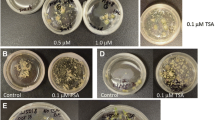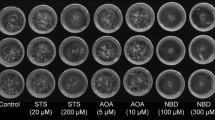Abstract
The objective of the study was to develop efficient widely adaptable microspore culture methodology for spring and winter wheat genotypes. Current wheat microspore culture methods are still inadequate for routine application, especially for winter genotypes. The present study involved increasing the frequency of microspore embryogenesis and improving the conversion of microspore-derived embryos to fertile green plants. A systematic evaluation was conducted testing numerous factors at all phases of the microspore embryogenesis process. Results from pretreatments, maltose gradients, and histone deacetylase inhibitors are presented. A 28 days cold pretreatment of spikes was optimal for winter wheat genotypes whereas a 21 days cold pretreatment was best for spring genotypes. Microspore suspensions containing a high frequency of embryogenic microspores were collected by resuspension in a 23% maltose gradient with subsequent pelleting with a mannitol containing solution. The application of trichostatin A (TSA) enhanced embryogenesis and/or green plant regeneration. Other epigenetic chemicals like scriptaid, BIX-01294, and sodium butyrate were also evaluated. Scriptaid enhanced embryogenesis but regenerated plantlets showed abnormal shoot and root development. The improved methodology was validated using a range of spring and winter wheat genotypes.
Key message
Enhanced microspore embryogenesis and green plant regeneration in spring and winter wheat was observed with 21 or 28 days cold pretreatments, a 23% maltose gradient, and the application of trichostatin A (TSA).


Similar content being viewed by others
References
Asif M, Eudes F, Goyal A, Amundsen E, Randhawa H, Spaner D (2013a) Organelle antioxidants improve microspore embryogenesis in wheat and triticale. Vitro Cell Dev Biol-Plant 49:489–497
Asif M, Eudes F, Randhawa H, Amundsen E, Yanke J, Spaner D (2013b) Cefotaxime prevents microbial contamination and improves microspore embryogenesis in wheat and triticale. Plant Cell Rep 32:1637–1646
Bajaj YPS (1990) Biotechnology in wheat breeding. In: Bajaj YPS (ed) Biotechnology in agriculture and forestry, vol 13. Wheat. Springer-Verlag, New York, pp 3–23
Berenguer E, Bárány I, Solis M-T, Pérez-Pérez Y, Risueño MC, Testillano PS (2017) Inhibition of histone H3K9 methylation by BIX-01294 promotes stress-induced microspore totipotency and enhances embryogenesis initiation. Front Plant Sci 8:1161
Castillo AM, Sanchez-Diaz RA, Valles MP (2015) Effect of ovary induction on bread wheat anther culture: ovary genotype and developmental stage, and candidate gene association. Front Plant Sci 6:402. https://doi.org/10.3389/fpls.2015.00402
Clement C, Sangwan RS, Sangwan-Norreel B (2005) Microspore embryo induction and development in higher plants: cytological and ultrastructural aspects. In: Palmer CE, Keller WA, Kasha KJ (eds) Biotechnology in agriculture and forestry, vol 56. Haploids in crop improvement II. Springer-Verlag, New York, pp 53–71
Devaux P, Pickering R (2005) Haploids in the improvement of poaceae. In: Palmer CE, Keller WA, Kasha KJ (eds) Biotechnology in agriculture and forestry, vol 56. Haploids in crop improvement II. Springer-Verlag, New York, pp 215–242
Ferrie AMR, Caswell KL (2011) Isolated microspore culture techniques and recent progress for haploid and doubled haploid plant production. Plant Cell Organ Cult 104:301–309
Gamborg OL, Miller RA, Ojima K (1968) Nutrient requirements of suspension cultures of soybean root cells. Exp Cell Res 50:151–158
Hansen NJP, Andersen SB (1998a) In vitro chromosome doubling with colchicine during microspore culture in wheat (Triticum aestivum L.). Euphytica 102:101–108
Hansen NJP, Andersen SB (1998b) Efficient production of doubled haploid wheat plants by in vitro treatment of microspores with trifluralin or APM. Plant Breed 117:401–405
Humphreys DG, Knox RE (2015) Doubled haploid breeding in cereals. In: Al-Kayri J, Jain SM, Johnson D (eds) Advances in plant breeding strategies: breeding, biotechnology and molecular tools. Springer International Publishing, Switzerland, pp 241–290
Hunter CP (1988). Plant regeneration from microspores of barley (Hordeum vulgare L.). Ph.D. Thesis, Wye College, University of London, London, UK
Inagaki MN (2003) Doubled haploid production in wheat through wide hybridization. In: Maluszynski M, Kasha KJ, Forster BP, Szarejko I (eds) Doubled haploid production in crop plants: a manual. Kluwer Academic Publishers, Dordrecht, pp 53–58
Indrianto A, Barinova I, Touraev A, Heberle-Bors E (2001) Tracking individual wheat microspores in vitro: identification of embryogenic microspores and body axis formation in the embryo. Planta 212:163–174
Jiang F, Ryabova D, Diedhiou J, Hucl P, Randhawa H, Marillia E-F, Foroud NA, Eudes F, Kathiria P (2017) Trichostatin A increases embryo and green plant regeneration in wheat. Plant Cell Rep. https://doi.org/10.1007/s00299-017-2183-3
Kasha KJ, Simion E, Miner M, Letarte J, Hu TC (2003) Haploid wheat isolated microspore culture protocol. In: Maluszynski M, Kasha KJ, Forster BP, Szarejko I (eds) Doubled haploid production in crop plants: a manual. Kluwer Academic Publishers, Dordrecht, pp 77–81
Kathiria P, Diedhiou J, Marillia EF (2016) Improvement in wheat carbon flux for increased yield and harvest index. Canadian Wheat Alliance meetings; Saskatoon, July 2016
Khound R, Santra M, Baenziger PS, Santra DK (2013) Effect of cold-mediated pretreatment on microspore culture in winter and spring wheat. Am J Plant Sci 4:2259–2264
Lantos C, Pauk J (2016) Anther culture as an effective tool in winter wheat (Triticum aestivum L.) breeding. Russ J Genet 52:794–801
Laurie DA, Bennett MD (1986) Wheat x maize hybridization. Can J Genet Cytol 28:313–316
Letarte J, Simion E, Miner M, Kasha KJ (2006) Arabinogalactans and arabinogalactan-proteins induce embryogenesis in wheat (Triticum aestivum L.) microspore culture. Plant Cell Rep 24:691–698
Li H, Soriano M, Cordewener J, Muino JM, Riksen T, Fukuoka H, Angenent GC, Boutilier K (2014) The histone deacetylase inhibitor trichostatin A promotes totipotency in the male gametophyte. Plant Cell 26:195–209
Maluszynski M, Kasha KJ, Forster BP, Szarejko I (2003) Doubled haploid production in crop plants: a manual. Kluwer Academic Publishers, Dordrecht
O’Donoughue LS, Bennett MD (1994) Durum wheat haploid production using maize wide crossing. Theor Appl Genet 89:559–566
Pandey P, Daghma DS, Houben A, Kumlehn J, Melzer M, Rutten T (2017) Dynamics of post-translationally modified histones during barley pollen embryogenesis in the presence or absence of the epi-drug trichostatin A. Plant Reprod 30:95–105
Santra M, Ankrah N, Santra DK, Kidwell KK (2012) An improved wheat microspore culture technique for the production of doubled haploid plants. Crop Sci 52:2314–2320
Scagliusi SM (2014) Establishing isolated microspore culture to produce doubled haploid plants in Brazilian wheat (Triticum aestivum L.). Aust J Crop Sci 8(6):887–894
Shariatpanahi ME, Belogradova K, Hessamvaziri L, Heberle-Bors E, Touraev A (2006) Efficient embryogenesis and regeneration in freshly isolated and cultured wheat (Triticum aestivum L.) microspores without stress pretreatment. Plant Cell Rep 25(12):1294–1299
Soriano M, Cistue L, Castillo AM (2008) Enhanced induction of microspore embryogenesis after n-butanol treatment in wheat (Triticum aestivum L.) anther culture. Plant Cell Rep 27:805–811
Zhang L, Zhang Y, Gao Y, Jiang X, Zhang M, Wu H, Liu Z (2016) Effects of histone deactylase inhibitors on microspore embryogenesis and plant regeneration in Pakchoi (Brassica rapa ssp. chinensis L.). Sci Hortic 209:61–66
Zheng MY (2003) Microspore culture in wheat (Triticum aestivum) doubled haploid production via induced embryogenesis. Plant Cell Tissue Organ Cult 73:213–230
Zheng MY, Liu W, Weng Y, Polle E, Konzak CF (2001) Culture of freshly isolated wheat (Triticum aestivum L.) microspores treated with inducer chemicals. Plant Cell Rep 20:685–690
Zheng MY, Liu W, Weng Y, Polle E, Konzak CF (2003) Production of doubled haploids in wheat (Triticum aestivum L.) through microspore embryogenesis triggered by inducer chemicals. In: Maluszynski M, Kasha KJ, Forster BP, Szarejko I (eds) Doubled haploid production in crop plants: a manual. Kluwer Academic Publishers, Dordrecht, pp 83–94
Zheng MY, Bieren K, Griggs R (2015) Developmental dynamics of wheat (Triticum aestivum L.) microspores under culture. Adv Biosci Biotechnol 6:693–701
Acknowledgements
Ploidy analyses were conducted at NRC as well as the Global Institute for Food Security, Saskatoon. We thank Rick D. Goertzen for his invaluable guidance and assistance as well as Dr. Timothy Sharbel for helpful advice on our analyses. The authors also thank NRC Canadian Wheat Improvement Program for funding.
Author information
Authors and Affiliations
Contributions
HMW, JLE, KLN, JMB, and TDO contributed by performing experiments and compiling data. HMW, JLE, and AMRF participated in drafting the manuscript. AMRF provided the concept for the study, data interpretation, and critical revisions. All authors reviewed the final manuscript.
Corresponding author
Ethics declarations
Conflict of interest
The authors declare that they have no conflict of interest.
Additional information
Communicated by Sergey V. Dolgov.
Publisher's Note
Springer Nature remains neutral with regard to jurisdictional claims in published maps and institutional affiliations.
Rights and permissions
About this article
Cite this article
Wang, H.M., Enns, J.L., Nelson, K.L. et al. Improving the efficiency of wheat microspore culture methodology: evaluation of pretreatments, gradients, and epigenetic chemicals. Plant Cell Tiss Organ Cult 139, 589–599 (2019). https://doi.org/10.1007/s11240-019-01704-5
Received:
Accepted:
Published:
Issue Date:
DOI: https://doi.org/10.1007/s11240-019-01704-5




